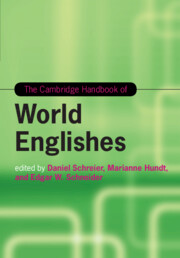Book contents
- The Cambridge Handbook of World Englishes
- Cambridge Handbooks in Language and Linguistics
- The Cambridge Handbook of World Englishes
- Copyright page
- Dedication
- Contents
- Figures
- Maps
- Tables
- Notes on Contributors
- 1 World Englishes: An Introduction
- Part I The Making of Englishes
- Part II World Englishes Old and New
- 7 A Sociolinguistic Ecology of Colonial Britain
- 8 English in North America
- 9 English in the Caribbean and the Central American Rim
- 10 English in Africa
- 11 English in South Asia
- 12 English in Southeast Asia
- 13 World Englishes Old and New: English in Australasia and the South Pacific
- Part III Linguistics and World Englishes
- Part IV Current Challenges
- Index
- References
11 - English in South Asia
from Part II - World Englishes Old and New
Published online by Cambridge University Press: 16 December 2019
- The Cambridge Handbook of World Englishes
- Cambridge Handbooks in Language and Linguistics
- The Cambridge Handbook of World Englishes
- Copyright page
- Dedication
- Contents
- Figures
- Maps
- Tables
- Notes on Contributors
- 1 World Englishes: An Introduction
- Part I The Making of Englishes
- Part II World Englishes Old and New
- 7 A Sociolinguistic Ecology of Colonial Britain
- 8 English in North America
- 9 English in the Caribbean and the Central American Rim
- 10 English in Africa
- 11 English in South Asia
- 12 English in Southeast Asia
- 13 World Englishes Old and New: English in Australasia and the South Pacific
- Part III Linguistics and World Englishes
- Part IV Current Challenges
- Index
- References
Summary
From a bird’s-eye perspective, the English language in South Asia has developed from a contested colonial legacy into an asset within the linguistic ecology of the region, both intra-nationally and pan-regionally. With more and more speakers and contexts of use in a population of well over a billion, English has become a firmly entrenched South Asian language with distinctive characteristics, effectively the third-largest variety of English worldwide. This chapter outlines the sociohistorical background to the development of English in South Asia from the beginning of British colonialism in the area to the present day. The main focus is on English in India as the largest state to emerge out of the former British Raj and arguably the historical input variety to other South Asian Englishes. In presenting distinctive features of Indian English vis-à-vis other South Asian Englishes, the notion of Indian English as the regional epicenter is also taken into account.
- Type
- Chapter
- Information
- The Cambridge Handbook of World Englishes , pp. 236 - 262Publisher: Cambridge University PressPrint publication year: 2020



